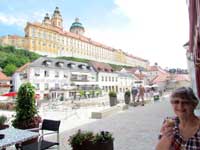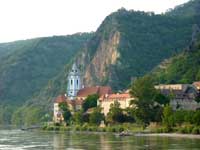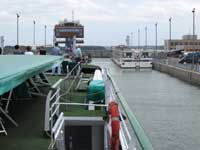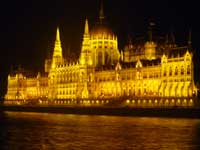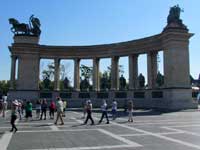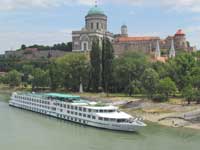A River Cruise from Vienna through Austria, Slovakia and Hungary in June 2014 on MV Beethoven
Three Countries on the Danube (download 640KB PDF file) | Map
Three Countries on the Danube
The Ship - MV Beethoven
Three days after leaving home we arrived in a hot and sunny Vienna and embarked on CroisiEurope's MV Beethoven for our week on the Danube.
The boat was built in 2004 but in the traditional style; it is 110metres long and 11.4metres wide with accommodation for 180 passengers. Almost all the river boats are the same width but they do vary in length to some extent. The width is dictated by the size of the various locks through which we pass.
The boat interior is well-designed and comfortable. The air-conditioned cabins, while not spacious are adequate, and all have an en-suite bathroom. On the top deck, where we were located, the cabins have large, fully-opening and sliding windows (called French Balconies), which allowed us to enjoy fresh air at night instead of the air-conditioned variety, welcome though that is in the heat of the day. Cabins on the two lower decks are less airy, with the middle deck having small sliding sections at the top of the 'picture' windows while those on the lower deck, at water level, do not open at all.
The salon is large enough to accommodate all the passengers at once in a comfortable mix of squashy leather couches and firmer upright chairs. The dining room has a mixture of tables for two, four or six and we were allocated our tables on arrival. We were on a table for six and very lucky in our dining companions. The passengers were a cosmopolitan mix of French, German, Spanish, Finnish, British and sundry odd-bods, a pair of Australians and us, the only Kiwis.
The food was excellent and far too plentiful. All beverages, hot, cold, alcoholic or not, were free of charge and it was impossible to sit for more that a few moments without being asked if one would like "to drink something" by one of the delightful Hungarian bar staff; they looked quite disappointed if one declined!
Melk, Austria
We set off from Vienna in the late evening and enjoyed a leisurely voyage upriver to the ancient town of Melk. Leisurely for the passengers, that is, but considerably less so for the vessel as the currents in the Danube are very strong so the engines were going flat out to make headway.
The town is dominated by a high rock upon which is a simply enormous Abbey with countless rooms, some of which have been renovated in the old style. Others have been arranged to reflect the styles of the many centuries of the Abbey's existence, right to the present day. Opinions vary as to whether this was a good decision but it was generally thought to be a clever way to reflect its history. Two rooms stand out in the memories of those who visited: the library, in which all the books were identically bound and the salon lined completely in mirrored glass. The gardens are justly renowned and most of the people who took the guided tour, would have liked longer to enjoy them.
We were unable to visit the Abbey as it was beyond the ability of Sarah's artificial joints to climb to it from the riverbank and, sadly, there were no taxis to be had. We did, however, manage the flat walk into the lovely cobble-paved town, in spite of extensive road works making a nonsense of the footpaths. The town features numerous very attractive, medieval buildings, many of them private houses. Everywhere we wandered there were little alleyways and courtyards, most with colourful window boxes and planters overflowing with geraniums in every shade from palest pink to rich crimson. The views of the Abbey from the town were quite spectacular and gave a far better appreciation of its architecture and scale. Those who took the tour of the Abbey missed seeing it from this perspective. The tour group also missed seeing the town and many regretted it. While we would have liked to see the grounds and some of the more interesting rooms, regular readers of these travel blogs will know that we dislike being frog-marched around by garrulous guides. All in all, we felt that we had the better experience of Melk and all it had to offer.
Lunch was served on board as we made our way to...
Durnstein, Austria
Durnstein is another ancient town dominated by huge craggy rocks. On top of the highest is the ruin of a formidable castle in which Richard the Lionheart was imprisoned, allegedly for some fiscal improprieties during the Crusades. Stories of his faithful servant Blondel locating his master by dint of singing his favourite nursery song under every castle window along the Danube until he heard him joining in the refrain are, sadly, pure fiction, which we think is rather a shame! The ruins are only accessible on foot, by experienced walkers with the proper boots, but it seems to us that they are better appreciated from below. One of our table companions, a keen walker and climber, decided not to attempt the climb but to enjoy it from river level.
The town itself, like Melk, featured cobbled streets and colourful window boxes as well as tumbledown houses and another castle, now a hotel. A large, very beautiful church, with a cerulean blue-painted tower, is what remains of an abbey built for the 'choir monks' and it is still renowned for the quality of the music.
This part of the river is popular with local people who like to swim from its small beaches and cycle along the flat riverside paths. We were all somewhat amused at lunchtime when I happened to look out of the window and see a very well-upholstered woman playing with her dog, running in and out of the river, totally naked (the woman, not the dog ... he still had his coat on!).
We made our way, very fast and with very little engine-power, downstream through Vienna in the middle of the night, to...
Bratislava, Slovakia
Bratislava is the capital of Slovakia and the only capital city in the world to be bordered by two other countries (Austria and Hungary). We were off the ship by 8.45, the temperature being already in the mid 20s, and walked into the town centre. We loved the cool, shaded, tree-lined streets, parks and squares, especially all the quirky statues and sculptures which are dotted about the place. Although there is no particular 'must see' in the guide books, apart, perhaps, for St Michael’s Gate with its elegant tower, in the medieval quarter of the city we found lots of interesting buildings in various states of renovation or disrepair, but all very picturesque. There is a castle on top of the hill (of course!) but it isn't particularly noteworthy and people on the tour said it was a bit of a con because it had been destroyed in an uprising and what is there now is a poor replica, built in the late 1950s. Again, we felt we had the better day because those on the tour didn't get a chance to explore the city and get a feel for the atmosphere. A bonus was that it was a Sunday so the streets were quiet with virtually no traffic and as we walked past the many churches, we could hear the singing and chanting, which was quite lovely. We found a cafe in a tiny, quiet courtyard tucked away off the main drag and had a truly sinfully chocolate-y hot chocolate smothered with whipped cream and a very good espresso coffee. We were back on board by 11am after a very pleasant morning.
We then set sail at noon for the long voyage to Kalocsa.
We passed through a number of locks during the voyage, mostly at night
though we did go through one, the deepest, in daylight which was interesting.
What was also interesting was that the mould and algae growing on the
walls of the lock changed markedly the deeper it was. As the locks are
operated many times a day and so the lowest level was exposed almost as
much as higher up, we wondered why there was such a difference.
In the evening the crew gave a very off-the-wall show with lots of skits
and jokes, of which we understood about half as they were obviously mickey-takes
of French TV shows; all the French passengers were in stitches throughout
(a funny sight in itself as a lot of them were rather on their dignity
the rest of the time!). Afterwards we all went on to the top deck for
what we were told would be a surprise and the highlight of the voyage:
We sailed through Budapest and were totally overawed by the sheer jaw-dropping beauty of the place, with its many huge, spectacularly ornate buildings and numerous bridges, all floodlit. It had started to rain and then a storm arrived and incredibly bright forked lightning lit up the sky and those buildings which weren't floodlit. The rain made the whole place sparkle even more brightly. It was a sight we'll never forget. We knew it was a beautiful city but this really defied description... you will just have to and see it for yourself!
Kalocsa, Hungary
Hmm....this won't keep you long! We never actually made it to the town, which turned out to be quite a long taxi ride from the dock and as it was very wet when we arrived at the mooring we decided not to bother. There was a small souvenir shop at the top of the gangway so, when the rain stopped, we went and had a look at that and then took a 15 minute walk around the locality (not even a village, really). There was an attractive thatched building which was a desultory attempt at a rustic museum and might have warranted a visit had it not been closed.
The most interesting thing about Kalosca was that the farmers still used horse and cart to carry themselves and produce to market; hard to imagine that a member of the EU could still be so primitive and we understood why the Hungarian government is trying to bring more foreign investment into the area, tourism being the main thrust of their efforts. Those who had taken the optional trip to the Hungarian Prairie and Horse Show felt that they would have to try considerably harder to make something which would attract tourists and the majority of them described it as boring flat, grassy landscape, though the show, which was like a cowboy rodeo but with some trick riding as well as skilful manipulation of up to six horses from the bare back of one of them, was quite impressive. An advertised 'highlight' of the tour was a visit to a paprika museum, this being the centre of the paprika producing industry. Who knew there was so much to be said about this humble ingredient? Everyone bought paprika in one form or another, most of it accompanied by a recipe for goulash, which we will try when we get home.
Embroidery is a popular cottage industry, with most of the women producing bright, floral designs (some even incorporating the red paprika pepper) and there were some very attractive bookmarks, table linen and aprons for sale. The general consensus, however, was that the time spent on the long voyage down to Kalocsa and back would have been better spent on an extra day in Budapest.
Budapest, Hungary
We had a great day in Budapest which comprises the twin cities of Buda and Pest, divided by the Danube. Of course a one-day visit can never do justice to a city so rich in history and we soon realised that we'd never be able to conquer it on our own without some orientation so broke our usual no-tour rule and booked on the ship's city tour. We had a very full three hours of being driven round the many highlights.
We passed a number of salutary reminders of some of the worst excesses of the 20th Century. The poignant Holocaust memorial featuring bronze shoes littered along a portion of the riverbank esplanade was particularly moving. The Terror House, an unassuming white building, hardly hinted at its former use as the headquarters of the Secret Police. It now houses a museum focusing on the atrocities perpetrated by the fascist and Stalinist regimes as well as the 1956 uprising. The only external sign that this is anything other than just another block of offices or apartments is the sculpture outside, in the form of a curtain made of a mass of chains, depicting the Iron Curtain.
We walked though the Parliament Square in Pest, where we saw the Changing of the Guard - three rather scruffy, brown-uniformed, soldiers carrying ancient, scratched and dusty old WWII .303 rifles, goose-stepping across the parade ground. While the grand parliament building is in superb condition, the administrative offices opposite were less well cared for. The bullet holes from the time of the uprising were still in evidence and we doubt it had had so much as a coat of paint since then.
Then we went on to Heroes Square, which was somewhat reminiscent of Tiananmen Square in China but without the red flags and pictures of Chairman Mao. The huge monument was created in 1896 to honour the millennium of the Magyar conquest of the Carpathian Basin. It is very apparent that this had been a communist country, only just emerging from that oppressive regime; any questions with a political flavour were skirted around and left unanswered.
Something which puzzled us was the guide's assertion that there was no Muslim community in the country; moments later we passed a large and magnificently decorated mosque.
We were then taken across the river to Buda, and up the hill to St Mathias Square. Here we found the gothic-style church of St Mathias largely designed in 1896 but with parts, notably the carvings over the door, dating back 500 years. A very ornate equestrian statue of St Stephan was under renovation and new cobbles were being laid around its base so we were unable to get close enough to read the inscription but as it was probably in Hungarian we wouldn't have left any the wiser. Sundry other buildings, notably the neo-gothic Fishermen's Bastion, a fanciful conglomeration of turrets and thick stone walls, perched high above the city, afford breathtaking views. From the river level, when floodlit at night, the complex looks like a fairytale castle. It was interesting to see the difference between the buildings at night and during the day; because they were spotlit in a golden glow, we assumed that they must have been built out of a gold-hued stone but actually, they are almost all a silvery grey, the colour of the local stone. Indeed, at certain points it was hard to tell where the building ended and the cliff began. There is a cog railway running up to the summit but it was very crowded, with long queues, so we didn't attempt to take it.
The elegant Liberty Monument dominates the city from the Gellert Hill; it depicts a beautiful woman holding aloft a palm frond, the symbol of freedom. One of the guides told us that she was holding a fish - a joke, mischief or a slip of the tongue? The 14ft high statue was erected in 1947 to commemorate the Soviet soldiers who died liberating Budapest in 1945 and originally it was surrounded by statues of those soldiers, on a plinth engraved with their names. The soldiers' statues and the plinth were removed to Memento Park in 1992.
In the afternoon we took a ride on a tram (public transport is free for EU citizens over-65; we were glad we'd taken our UK passports, although we were never asked for proof of eligibility) and visited the old market hall, which was very ornate with lots of fancy, colourful tile-work on the outside while the inside was a huge space supported by hundreds of steel girders with ornate tracery. The ground floor was all food, with delicatessens, fruit and vegetable stalls and pork butchers being the main produce on sale; the smell was heavenly and if we weren't so well fed on board it would have been hard to resist buying something tasty! Half the upper floor was given over to souvenir stalls, all pretty much the same and all with obviously Chinese-made tat but the rest of the floor offered fast-food cafes selling every Hungarian specialty from goulash to stuffed cabbage rolls, paprika salami to pastries. Again, we almost wished we had been hungry!
We then walked back to the ship, via the pedestrianised shopping street with a fascinating mix of architectural styles, obviously restored, since they would have been damaged during the 1956 revolution, but very well and sympathetically done. There are myriad shops selling everything from souvenirs (better quality than the market but priced accordingly), leather handbags, hats and sunglasses to designer clothing and high quality home-ware and even hunting weapons.
Esztergom, Hungary
Esztergom dates back to Roman times and Marcus Aurelius wrote his famous Meditations while camped there. King Stephen I, the founder of the state of Hungary, was crowned there in the 10th century and from then until the 13th century Esztergom was the capital and the seat of the Hungarian monarchy. The Turks virtually destroyed the town, including the original church built in the 12th century, in 1543 and much of it has been rebuilt, mainly in the 18th and 19th centuries. It still retains much of the ambiance and charm of the original medieval town, however.
The spectacular Basilica, built on the site of the destroyed one, is perched high above the river from which, rounding a bend, one gets the first breathtaking views of the massive dome. Building started in 1822 and it is in the neoclassical style, although the oldest part is the remaining chapel built in 1510 of red marble featuring Italian Renaissance carving and sculpture. The striking dome of the Basilica is third only in size to St Peters in Rome (Vatican City) and St Paul's in London, which means it's the third largest in the northern hemisphere. At 13.5 × 6.6 metres, the altar piece depicting the Assumption of the Blessed Virgin Mary, by Girolamo Michelangelo Grigoletti, is the largest painting in the world on a single piece of canvas. In the grounds of the Basilica, there is a very elegant sculpture of the coronation of King Stephen. Until we learned the history of the town, it seemed strange to have such a significant building in what is now such an insignificant place. There is a lot more to see in Esztergom, including museums and the Treasury but there was only so much one could do in a day.
The Esztergom we see today has become a very expensive 'dormitory' town for people working across the bridge in Párkány (Sturovo) in Slovakia. Though only the width of the river apart, the difference was very apparent. The Slovakian town was very utilitarian with the buildings almost all in the uncompromising Soviet brutalist style, though to be fair a couple of apartment blocks did feature the odd splash of red or yellow on their balconies; somehow this only made them seem all the more depressing amid the uniform drabness of the town. It was all a far cry from the capital, Bratislava. One could easily understand why those who could afford it chose to live across the river and make the 10 minute commute each day.
Hungary is a strange country which doesn't seem to quite fit in anywhere at the moment but they do seem to be trying to shrug off their past and improve their lot. They are members of the EU but we can't understand why the EU admitted them as their human rights record is appalling and their economy is a basket case, much worse than some countries which have been refused membership. We suspect it is that they're now a non-communist buffer state among a lot of less enlightened middle-European and Russian states. We gather that the EU is pouring vast sums of money into the country to help modernise the infrastructure and repair the ravages of decades of neglect.
We left Hungary behind as we made our way towards Vienna and the final visit of our cruise. It was while en route from Esztergom to Vienna that we had a close encounter with a sandbank ...
A very large, fast, German, cement-carrying barge which appeared to be completely out of control, with its tug in totally the wrong place to keep it on the straight and (very) narrow, was seen to be heading straight for us! Our Captain had no choice but to veer sharply away, to the wrong side of the marker buoy ... and straight onto a sandbar. The rogue vessel missed us by a small margin and sped off on his way, though he would no doubt have been picked up at the next control station; you may be sure our man would have sent a very pithy signal telling the authorities of this recklessness. There was a small inflatable dinghy dodging around and the kindest interpretation was he was trying to avoid that, but in truth, we were not sure he even knew it was there. It took us a good half hour to work free of the sandbar and get on our way. This appears to have been achieved by persuading a couple of barges coming the other way to come fairly close to us and speed up, causing waves which helped lift us off. All very exciting in hindsight, but there were a few anxious moments when it looked as though we might be stuck until a rescue boat could be sent from Vienna ... and dusk was falling rapidly so it would soon be dark.
Vienna, Austria
We got to Vienna in good time, in spite of our misadventure, and were docked by 6am. By 8.30, after yet another over-indulgent breakfast, we set off to re-acquaint ourselves with the city. This wonderful city, with its wealth of exuberant baroque architecture, really needs no introduction and there can be few people who wouldn't immediately recognise the famous Opera House, museums, art galleries, theatres and grandiose government buildings. We wanted to see them all again but with limited time we decided to make do with a drive-past by tram and to concentrate on our favourite quarter of the city, which is anything but baroque.
We took an underground train to the city centre and there we changed to a tram to the Hundertwasser House, village and museum. We spent all morning there and have taken far too many photos, some of which you can see here. There was another reason for revisiting Hundertwasser's work as our elder grandson had been studying his work at school. Hundertwasser was a resident of our part of New Zealand in the last years of his life. We promised to send photos and information to our grandson's class teacher and we were able to tell them that we saw a lot of Hundertwasser's writings, pictures and models in the museum and that he would have been very happy to see the children's interpretation of his work and philosophy of design.
Later, we got a tram, which went half way round the Ring, to the other 'must' on our Vienna itinerary: the Hotel Sacher. We had been there on our first visit to Vienna many years ago and enjoyed a slice of the famously decadent chocolate and apricot Sacher torte - so much that we simply had to repeat the experience. It did not disappoint and the cake with coffee quite spoilt our appetite for dinner! So popular is the delicacy that hundreds of the cakes are posted all over the world each year - they send them in their own little wooden box with brass corners. We investigated having one sent to our daughter for her birthday - but it was going to cost over $100 for a 4-slice size, which was, sadly, prohibitive.
After our treat we caught a little electric bus through the winding back lanes of the city to the cathedral square and then a tram to complete our circuit of Ringstrasse, which is where all the grand buildings are situated. Almost all are extravagantly ornate with statues, domes, curlicues and gold embellishments; not our favourite architectural style but amazing to see, and to wonder at the skill and artistry that went into its creation. We then got the train back to the main interchange where we sprung for a taxi back to the boat.
Back on board MV Beethoven, we enjoyed the last night of our wonderful week exploring just some of the towns and cities on the banks of the River Danube.
Three Countries on the Danube (download 640KB PDF file) | Map





